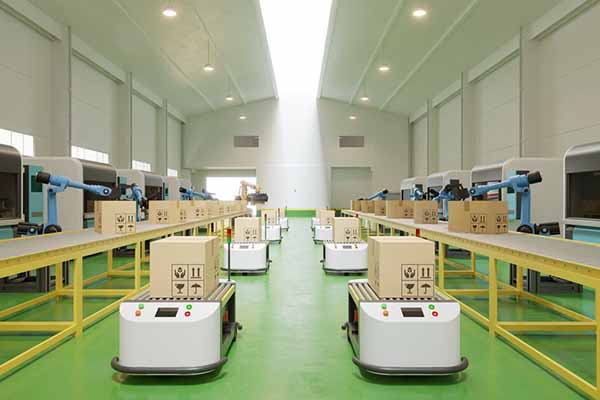Autonomous Mobile Robots (AMRs) are the future of hazardous/complex material handling in manufacturing/warehousing and efficient logistic center operations. To realize this future, AMRs often require human-like capabilities and flexibility. Design/development tools and hardware systems are needed to achieve these enhanced capabilities while ensuring safety and reliability.
This article aims to educate readers on the resources and tools available to aid in the design and development of AMRs and the hardware systems key to a successful AMR.
Brains: AI/Machine Learning Systems & Control
For AMRs to be autonomous, they either need to follow a predefined program, follow a track, or be limited enough in operation that simple preprogrammed directives are suitable for their efficient operation. As this would limit the efficiency and productivity gains available from robotic technology, AMRs are generally considered more viable if powered by artificial intelligence/machine learning (AI/ML) algorithms that can be trained to readily tackle a diverse range of environments. This type of learning enables AMRs to be continually improved without specifically programming every potential interaction or operation. AMR AI/ML systems require two key components, a learning/development system and the necessary hardware to implement the AI/ML control and to sense/interact with the external environment and internal subsystems.
Artificial Intelligence/Machine Learning for AMR
The main functions of AI/ML systems for an AMR are to ensure safety, avoid obstacles, perform a set of given tasks autonomously, and to be readily trained for a new task if necessary. To do this, an AMR requires an AI/ML core, which can contain the AI/ML learning algorithms and data and the essential sensor, processing, and control hardware that can be directed and interpreted by the AI/ML core. The AI/ML core (model and inference/runtime engine) also needs to have a developed infrastructure from which it can be taught.
Developing an AI/ML core is not straightforward, rather it is often a lengthy and expensive undertaking. Because of this, there are pre-built AI/ML cores, or toolkits, that are designed and developed to be readily repurposed and integrated with a variety of compatible hardware options. These cores generally include development tools, a processing core, data storage, and interfaces that can be used to connect a range, or possibly even a single select, sensor(s). Such AI/ML cores may come equipped with an application programming interface (API), a variety AI/ML models supported, and software/development tools to interface with inference hardware.
AMR Artificial Intelligence/Machine Learning Hardware
An AI/ML system requires hardware to implement the AI/ML models and process the sensor inputs and control outputs fed to and sent from the model. This requires some type of processing hardware, which may be a microprocessor unit/computer processing unit (MCU/CPU), a graphics processing unit (GPU), a field-programmable gate array (FPGA), or some type of specialized hardware, such as application specific integrated circuit (ASIC) vision processing unit (VPU) or tensor processing units (TPUs).
The AI/ML hardware may often be implemented using a variety of processing units, such as a GPU or VPU to process incoming signals from image sensors and MCU/CPU and FPGA to handle sensor information and outputting control signals (Figure 1). In many cases, AMRs need to operate with determinism and real-time to ensure safety and efficiency. This means that the AI/ML models, software, and hardware must all operate with determinism and in real time.


Depending upon the tasks and sensor types, different combinations or numbers of processors may be optimal. For instance, if there is a large amount of camera vision data but power constraints, a VPU may be more efficient than a GPU, which is more generic. Conversely, if there are many vision systems on the AMR a single higher-powered GPU may be desirable over having several VPUs due to system complexity and power consumption.
Though an MCU/CPU is often general purpose and can be used for various tasks, they tend to be best suited to serial functions that need to be processed quickly. However, when given a high number of parallel tasks, an FPGA is likely an ideal solution, and given the type of FPGA chosen, could perform the processing/control tasks for a variety of functions, such as communication, motor control, and power conversion.
Brawn: Motor Control, Electric Motors, and Energy Storage
AMR mobility and actuation relies on electrical motors, motor control systems, and electrical energy storage. The two main motor control challenges for AMRs are mobility of the AMR chassis and actuation of the manipulators, which may be a variety of different armatures or as simple as a sled that raises and lowers. Naturally, the energy for these electric motors needs to be stored in some stable format, sufficiently energy dense and efficiently extracted.
Motor Control Technologies
The main motor control hardware options are single-board computers (SBCs) with CPUs and/or GPUs, MCU/digital-signal processors (DSPs), or FPGAs. The choice of which hardware motor control solution depends on the complexity and performance requirements of the drive and actuation. Generally, SBCs are much larger and consume more power but can be the most flexible and potentially powerful control option. MCUs/DSPs are smaller and compact and can be more readily coded. However, MCUs/DSPs have limited serial control capability and have hardware limitations in how configurable they can be. FPGAs with specialized hardware logic design can be the most energy efficient and highest performance option and intrinsically facilitate hardware parallelism. Unlike programming SBCs or MCU/DSPs, designing FPGA hardware requires specialized knowledge of hardware description language (HDL) and digital control system implementation.
Motor Types
Typical DC motors are not reliable enough or efficient enough for AMR applications. Though AC motors may be efficient and responsive sufficient for some AMR drive applications, these motors also require DC-AC inversion hardware that increases the cost and complexity of AC motor drive solutions while reducing efficiency. More common drive motors for AMRs are brushless DC motors, which are generally the highest performance and most efficient and require more complex control and DC to multi-phase conversion hardware.
Stepper motors are ubiquitous with actuation – and a well-established solution for actuation tasks – and are widely used in CNC machines and other machine control tasks. Another option would be a DC servo motor, which has more accuracy and speed benefits than stepper motors. However, servo motors are generally more expensive and complex to control than stepper motors. Moreover, servo motors are typically brushed motors, which means they require regular maintenance and replacement of the brushes, which may not be desirable for some AMR applications.
Energy Storage
Lithium battery chemistries are the most common high-energy density battery solution used for mobile robotics applications. Though there are various other battery cell types, such as AGM, gel, lead-acid, and even high energy density supercapacitors, Lithium batteries have an ideal balance of energy density and power density for AMR applications. As battery energy density directly relates to the overall weight of a battery system for a given energy storage capability, higher energy density is often desirable to have more compact and lower weight/efficient AMRs.
Eyes: 3D Vision, 2D Cameras, & Proximity Sensors
For AMRs to safely and efficiently navigate an environment, they need to sense that environment so that the sensor data can be rapidly processed to create maps, plan paths, and machine vision. Moreover, AMRs need responsive and high-resolution sensing data to manipulate objects effectively and ensure worker safety. This is why AMRs are often equipped with an array of vision sensors, both 3D and 2D visual sensors (cameras), and proximity sensors.
3D Vision & Visual Cameras
AMR machine vision applications typically need to run at a relatively high frame rate with high-resolution camera sensor input while minimizing processing overhead. This is why many machine vision systems use GPUs or VPUs specifically designed for handling high throughput image data and are compatible with various software development tools, such as Intel RealSense SDK and Open3D open-source library designed for processing 3D data.
With this 3D data, scans can be made of an environment to allow for real-time robotic navigation. 2D cameras may be used in 2D machine vision applications, such as certain actuation tasks, or an array of 2D cameras could be used to create a 3D vision system (Figure 2).

Proximity Sensors
Sensor fusion is generally a valuable tool in enhancing the accuracy of processed data. In the case of AMRs, as position and actuation tasks are often reliant on good position data of the AMR in its environment and between the AMR and target objects, additional proximity sensors can be extremely useful. Typical proximity sensor technologies include ultrasonic, infrared (IR), and laser radar (LIDAR). This proximity information coupled with a vision system could be used to augment an AMRs mobility and actuation capabilities with precision in the millimeters, where it may be more costly or difficult to achieve this with simply a vision system.
Ears/Mouth: Wireless Communications
Though AMRs can operate autonomously, it is often essential to receive regular reports, visual data, or direct an AMR with a new task. Without a manual tether, this requires wireless communication hardware systems that are tied into the AI/ML core. It is invaluable for these communication systems to be responsive, secure, and reliable. 4G LTE cellular communications systems have been widely deployed in industrial environments to connect a variety of sensors and even robotic systems. Along a similar vein, Wi-Fi communication systems have also been deployed in industrial settings to provide video surveillance, security, collect sensor data, and provide control of some industrial and robotic systems.
As AMR systems may often require real-time, low latency, and deterministic communication, neither standard 4G LTE or Wi-Fi are the best equipped for this application (Figure 3). There are proprietary systems built on 4G LTE cellular technology and even Wi-Fi to accomplish this. Nevertheless, the ultra-reliable and low latency (URLLC) features built into the 5G standard may be better suited for AMR applications, especially if multiple AMRs need to intercommunicate and coordinate. Though Wi-Fi systems are capable of peer-to-peer (P2P) communication, many 4G LTE systems are not, and this may be essential for any AMR application that involves multiple AMRs. Where an AMR may also need to communicate with a variety of other systems within an industrial environment, 5G massive-machine type communication (mMTC) features may also be desirable.

Conclusion
The future of manufacturing and logistics center order fulfillment is dependent on AMR hardware, from AI/ML systems to wireless communication systems. Considering this apparent need, a wide range of AMR hardware solutions are now available that are supported by hardware and software development tools to reduce the design cycle and optimize system performance.
About the author:

Jean-Jacques (JJ) DeLisle attended the Rochester Institute of Technology, where he graduated with a BS and MS degree in Electrical Engineering. While studying, JJ pursued RF/microwave research, wrote for the university magazine, and was a member of the first improvisational comedy troupe @ RIT. Before completing his degree, JJ contracted as an IC layout and automated test design engineer for Synaptics Inc. After 6 years of original research–developing and characterizing intra-coaxial antennas and wireless sensor technology–JJ left RIT with several submitted technical papers and a U.S. patent.
Further pursuing his career, JJ moved with his wife, Aalyia, to New York City. Here, he took on work as the Technical Engineering Editor for Microwaves & RF magazine. At the magazine, JJ learned how to merge his skills and passion for RF engineering and technical writing.
In the next phase of JJ’s career, he moved on to start his company, RFEMX, seeing a significant need in the industry for technically competent writers and objective industry experts. Progressing with that aim, JJ expanded his companies scope and vision and started Information Exchange Services (IXS).















